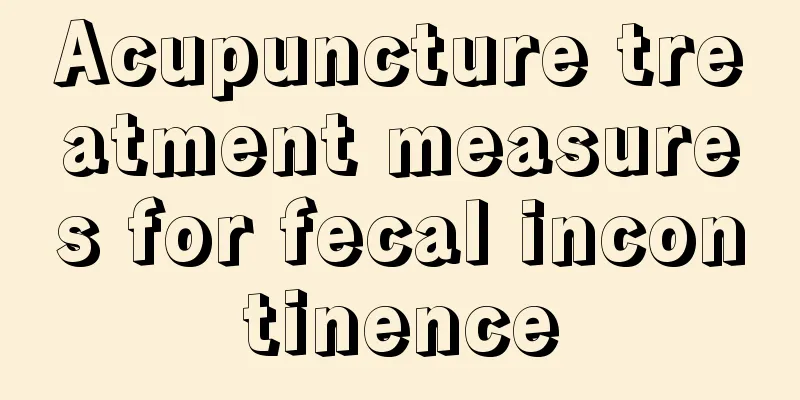Acupuncture treatment measures for fecal incontinence

|
Fecal incontinence means that feces cannot be controlled and flows out of the anus involuntarily. Its incidence rate is not very high. When it is completely incontinent, although it cannot directly endanger a person's life, it also causes physical and mental torture to the patient. I heard that acupuncture can treat fecal incontinence. Next, let’s take a closer look at how acupuncture treats fecal incontinence. 【Acupuncture symptomatic treatment】 Main acupoints: Changqiang, Baihui, Zusanli, Balu. Acupoints: add Hegu and Quchi for severe heat toxicity; moxibustion Guanyuan and Shenque for cold pathogenic injury; moxibustion Qihai and Baihui for qi deficiency; add Pishu, Shenshu and Mingmen for spleen and kidney yang deficiency. Operation: Conventional acupuncture, according to the principle of deficiency-tonifying and excess-purging. Changqiang obliquely puncture, the needle tip is inserted upward and parallel to the sacrum for 0.5-1 inch, and the rectum must not be punctured to prevent infection. Lifting, inserting, twisting and flat tonifying and flat purging method; Baihui punctures 0.5-1 inch backward and flat, twisting and tonifying method; Zusanli punctures 1-1.5 inches obliquely toward the abdomen, lifting, inserting, twisting and tonifying method; Bajing punctures 1-1.5 inches straight, lifting, inserting, twisting and flat tonifying and flat purging method. The acupoints are matched according to the principle of deficiency-tonifying and excess-purging, and the method of lifting, inserting, twisting and tonifying and purging is adopted, Guanyuan, Shenque, Qihai, and Baihui are moxibustioned. After acupuncture, the needle is retained for 30 minutes. Formula meaning: Changqiang and Bali are proximal acupoints, and needling them can regulate local qi and blood; Baihui is a Du channel acupoint, which has the function of raising yang and lifting the sunken, and has the meaning of treating lower diseases from above; Zusanli is a stomach meridian He point and a lower He point, and needling it can strengthen the spleen and replenish qi, and dredge the qi of the intestines. All the acupoints are used together, and the upper and lower parts are related, which can raise the yang of the spleen and stomach and imprison the anus and intestines. Combined with Gu and Quchi, it can clear the intestines and release heat; moxibustion Guanyuan and Shenque warm the interior and help yang; moxibustion Qihai and Baihui raise and replenish qi; Pishu, Shenshu, and Mingmen warm the kidney and strengthen the spleen. In addition to acupuncture treatment, non-surgical methods include: 1. Non-surgical treatment (1) Dietary adjustment: Treats inflammation of the anorectal canal, makes the stool firm, avoids diarrhea and constipation, and eliminates the discomfort caused by inflammation of the anorectal canal. The common method is to eat more high-fiber and nutritious foods and avoid irritating foods. If there is inflammation in the anorectal canal, antibiotics can be taken symptomatically. If there is inflammation in the perianal skin, you should always keep it clean and dry or apply topical medication. (2) Anal sphincter exercise: The method is to ask the patient to contract the anus (lift the anus) about 500 times a day, and hold it for a few seconds each time. This can enhance the function of the anal sphincter. (3) Stimulate the contraction of the anal sphincter. For patients with neurogenic anal incontinence, electrical stimulation therapy and acupuncture therapy can be used. Electrical stimulation therapy is to place the stimulation electrode in the external sphincter, use electrical stimulation to stimulate the anal sphincter and levator ani muscles to produce regular contractions, which can improve the condition of some patients with anal incontinence. Acupuncture therapy is a traditional Chinese medicine therapy. Some patients can also achieve good results. Commonly used acupoints are Changqiang, Baihui, Chengshan, etc. Fecal incontinence, also known as anal incontinence, can be treated with acupuncture. We have seen the method in the above introduction. Currently, if you want to confirm that you have fecal incontinence, in addition to correct medical interviews, the key is to rely on professional physical examinations such as endoscopy, rectal digital examination, defecography, electromyography, etc. to confirm the diagnosis. |
<<: What causes constant bloating in the stomach?
>>: What is the daily protein intake?
Recommend
What causes testicular cancer
As one of the most common cancers in young men, t...
Patients must combine the diagnosis basis of liver cancer as soon as possible
Liver cancer is a common tumor disease. It can ca...
What to do if you can’t remember things
If your brain always cannot remember things, it w...
The difference between fried dough stick powder and flour
There are some differences between fried dough st...
What foods should not be eaten in the liver cancer diet? Three dietary principles for liver cancer patients
Liver cancer is the same as other types of cancer...
What are the ways to wash off mango drops on clothes?
As we all know, once juice gets on clothes, espec...
Is obstructive pneumonia lung cancer?
Is obstructive pneumonia lung cancer? 1. For pati...
How to permanently remove facial hair?
Nowadays, both male and female friends have becom...
What should I do if I sprain my waist
Our waist is very fragile. When the waist is spra...
What are the symptoms of gastric cancer in the middle and late stages? There are three symptoms
In the middle and late stages of gastric cancer, ...
What should I do if I have bone cancer
What should I do if I have bone cancer? In fact, ...
What are the causes of prostate cancer? Are men with hair loss and baldness more susceptible to prostate cancer?
Many people are now panicking because it turns ou...
What are the principles of dietary care for liver cancer? Eat three kinds of bamboo shoots to stay away from liver cancer
Liver cancer is highly malignant and progresses q...
Furniture smells? This removes the effect well!
In our daily life, we always choose our favorite ...
Where should the alcohol bath be applied?
Everyone must be familiar with alcohol. When we s...









